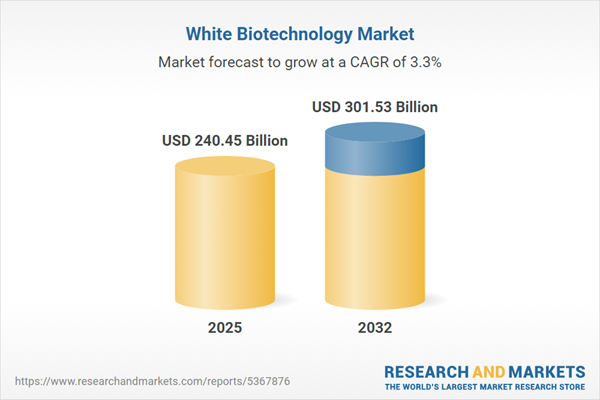Speak directly to the analyst to clarify any post sales queries you may have.
White biotechnology is reshaping business operations, equipping senior decision-makers with innovative solutions for efficiency, resilience, and compliance in an environment of evolving regulatory and sustainability demands. This market empowers organizations to adapt and thrive while modernizing value chains to meet both current and future standards.
Market Snapshot: White Biotechnology Market Trends and Growth Outlook
The white biotechnology market is expanding steadily, underpinned by a compound annual growth rate (CAGR) of 3.28%. This upward momentum is fueled by elevated investment, clear regulatory alignment, and a marked shift towards sustainable processes across multiple industries. Enterprises are leveraging developments in bioprocessing and bio-based product innovation to enhance resource use, respond proactively to environmental regulations, and future-proof their operations. Upgrading legacy supply chains and capitalizing on relevant policy incentives are further positioning white biotechnology as a keystone for compliance and enduring business value, enabling enterprises to remain agile amidst shifting regulatory landscapes and customer expectations.
Scope & Segmentation: Core Areas, Technology Platforms, and Regional Overview
- Product Types: L-lysine and L-threonine contribute to advanced animal nutrition and precision livestock practices. Biofuels enhance energy diversification and assist organizations in minimizing operational carbon footprints. Biopharmaceuticals, such as monoclonal antibodies and vaccines, enable expanded therapeutic possibilities. Bioplastics like PHA and PLA help address regulatory sustainability imperatives in packaging, and industrial enzymes support efficient manufacturing. Vitamins C and E add value to products with a focus on nutrition.
- Technology Platforms: Microbial and animal cell cultures provide scalable manufacturing options. Filtration and chromatography enhance downstream reliability of production. Progress in fermentation control and genetic engineering, including CRISPR and recombinant DNA technologies, produces sector-specific outcomes.
- Application Areas: White biotechnology strengthens food safety, elevates nutritional quality, and supports sustainable practices in industries such as textiles, leather, paper, waste management, and industrial cleaning. These applications play a central role in fulfilling compliance requirements and minimizing environmental impact.
- End Users: Agricultural operations adopt bio-fertilizers and biopesticides to improve crop health and land management. Animal feed producers increase amino acid inclusion to raise livestock productivity. Chemical manufacturers implement white biotechnology to create specialty products, while cosmetics brands employ bioactives for unique offerings. Pharmaceutical companies refine biological processes to drive drug development efficiencies.
- Raw Materials: Sourcing of agricultural feedstocks, including cassava, corn, sugarcane, and wheat, supports resilient supply chains and reduces dependence on petroleum-derived materials.
- Regional Coverage: Asia-Pacific, especially China, India, and Japan, leads innovation and manufacturing expansion. The Americas, Europe, and the Middle East and Africa all enhance sector growth through progressive regulations and collaborative investments, each contributing unique commercialization strengths.
- Notable Companies: Leading organizations—such as Novozymes A/S, DuPont de Nemours, Koninklijke DSM N.V., BASF SE, Archer Daniels Midland Company, Cargill Incorporated, Evonik Industries AG, Roquette Frères S.A., Corbion N.V., and Chr. Hansen Holding A/S—drive development through innovative, reliable solutions that tackle sector-wide challenges.
Key Takeaways for Senior Decision-Makers
- Implementing bio-based solutions across production and logistics networks aligns organizations with sustainability benchmarks and ensures readiness for dynamic regulatory conditions.
- Strategic alliances among research partners, supply chain actors, and in-house innovation units facilitate streamlined commercialization and protect valuable intellectual property.
- Integrating digital transformation and advanced biorefinery technologies supports operational resilience, empowering enterprises to respond quickly to changing market needs.
- Expansion of modular production methods and digital systems increases organizational flexibility, allowing for agile adaptation to market or policy fluctuations while maintaining stability.
- Involving regulators early and optimizing the use of regional incentives reinforce compliance resilience and enhance supply chain dependability.
- Proactive adoption of new biotechnological techniques prepares organizations for shifts in resource availability and supports implementation of sustainable processes.
Tariff Impact on Market Competitiveness and Supply Chains
Recent tariff adjustments in the United States have raised the cost of importing white biotechnology products. As a result, organizations are giving higher priority to domestic manufacturing capabilities, evaluating workflow integration, and reconsidering sourcing strategies. Engaging closely with trade authorities has become essential for managing transitional risks and maintaining reliable access to necessary products during changes in import policy.
Methodology & Data Sources
This analysis relies on extensive secondary research, regulatory landscape reviews, and targeted stakeholder interviews. Combined market financial data and detailed trade insights inform robust recommendations for executive-level planning and sector strategy.
Why This Report Matters for Business Leaders
- Supports supply chain strategists in forecasting the effects of new technology deployments and evolving regulatory landscapes within the white biotechnology sector.
- Provides executive teams with targeted insights for proactive risk management and identifying opportunities related to bio-based initiatives.
- Equips leadership with strategic context for advancing sustainability goals, enhancing competitive positioning, and achieving alignment with global bioeconomic shifts.
Conclusion
This report delivers actionable insights to guide enterprise innovation, streamline compliance, and enable business continuity in the fast-evolving white biotechnology market.
Additional Product Information:
- Purchase of this report includes 1 year online access with quarterly updates.
- This report can be updated on request. Please contact our Customer Experience team using the Ask a Question widget on our website.
Table of Contents
3. Executive Summary
4. Market Overview
7. Cumulative Impact of Artificial Intelligence 2025
Companies Mentioned
The companies profiled in this White Biotechnology market report include:- Novozymes A/S
- DuPont de Nemours, Inc.
- Koninklijke DSM N.V.
- BASF SE
- Archer Daniels Midland Company
- Cargill, Incorporated
- Evonik Industries AG
- Roquette Frères S.A.
- Corbion N.V.
- Chr. Hansen Holding A/S
Table Information
| Report Attribute | Details |
|---|---|
| No. of Pages | 186 |
| Published | October 2025 |
| Forecast Period | 2025 - 2032 |
| Estimated Market Value ( USD | $ 240.45 Billion |
| Forecasted Market Value ( USD | $ 301.53 Billion |
| Compound Annual Growth Rate | 3.2% |
| Regions Covered | Global |
| No. of Companies Mentioned | 11 |









